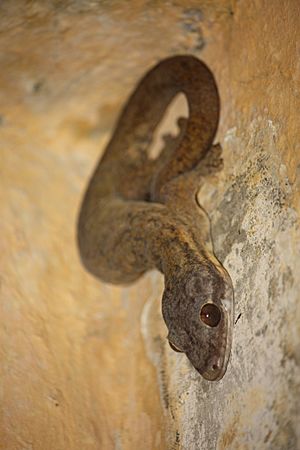Turnip-tailed gecko facts for kids
Quick facts for kids Turnip-tailed gecko |
|
|---|---|
 |
|
| in Dominica | |
| Conservation status | |
| Scientific classification | |
| Genus: |
Thecadactylus
|
| Species: |
rapicauda
|
| Synonyms | |
|
|
The turnip-tailed gecko (Thecadactylus rapicauda) is a species of gecko widely distributed from Mexico southward through Central America and into South America as far south as Brazil, and on many islands in the Lesser Antilles. It was long thought to be the only member of its genus, until T. solimoensis was described in 2007.
It is a large gecko, reaching a length of 120 mm snout-to-vent. Its color varies from pale to dark gray to deep orange. Individuals can also change color. It can vocalize a series of chirps, which it mainly does while active at night. Its name comes from its swollen tail, which is used to store fat. It also waves its tail as a sign of aggression, and can shed its tail to distract predators. They are nocturnal in nature and are frequently found 5–30 feet up the trunks of palm trees.
Names
It is called tai-marɛɁa in the Kwaza language of Rondônia, Brazil.
Predators
These include the phyllostomid bat, Choropterus auritus
Parasites
They include the malarial parasite Plasmodium aurulentum.
See also
 In Spanish: Thecadactylus rapicauda para niños
In Spanish: Thecadactylus rapicauda para niños


